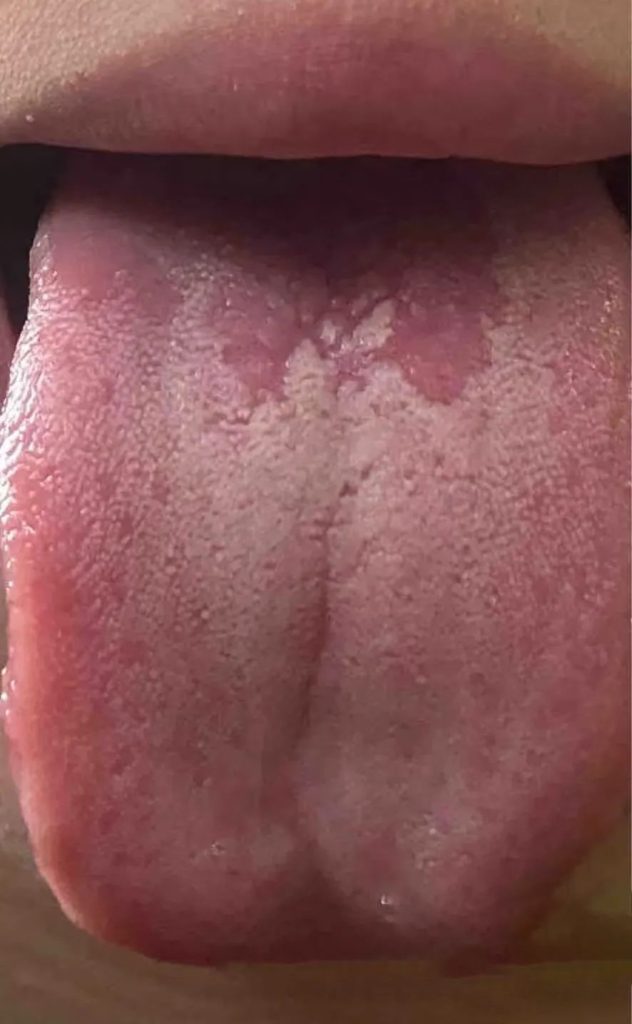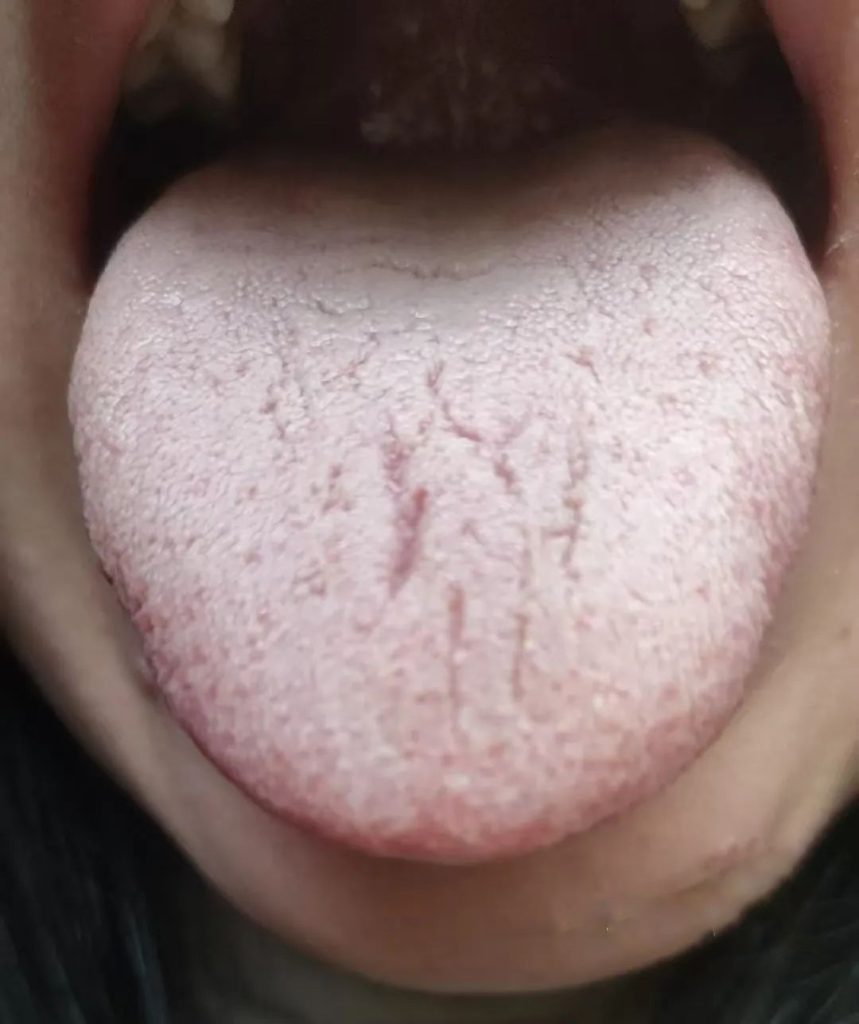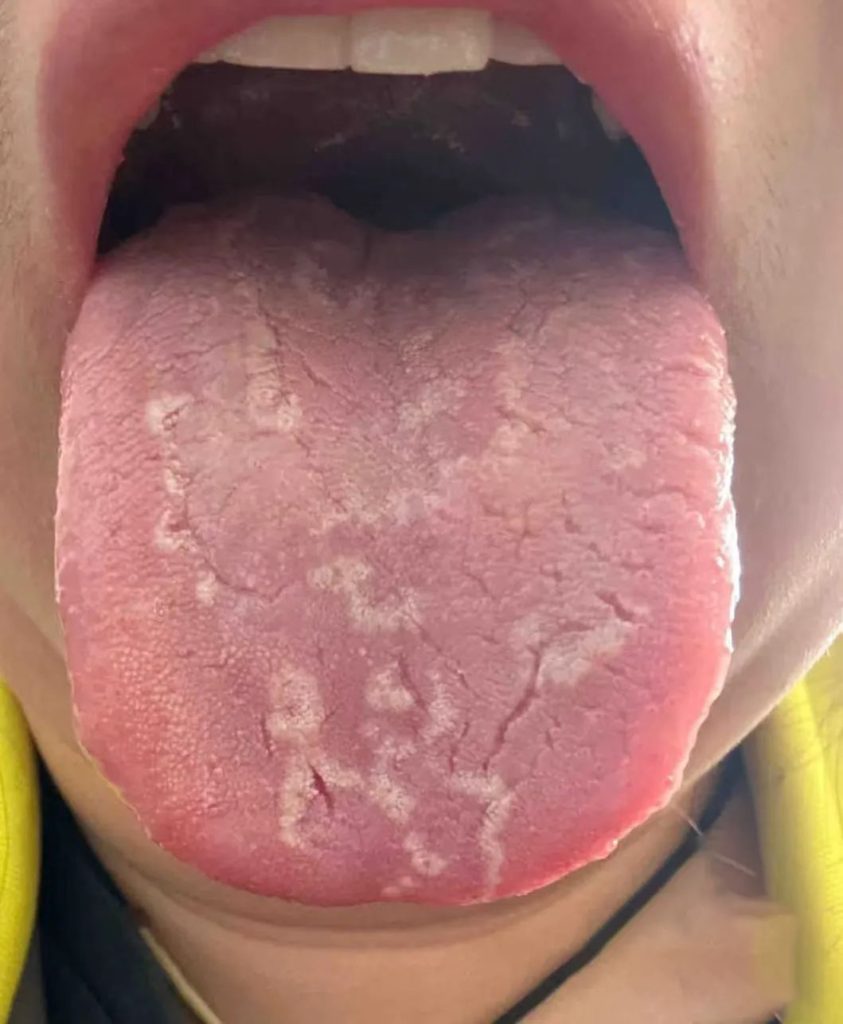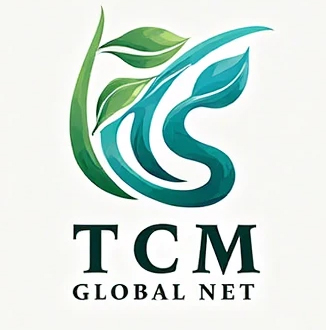Deconstructing the fissured tongue, I have reviewed ancient and modern medical texts, and the interpretations of fissured tongue are mostly complex and difficult to grasp, making them impractical for clinical application. Based on my clinical experience, I have summarized the core pathogenesis of fissured tongue as stagnation and yin deficiency.
I. Redefining Fissured Tongue: The Underlying Logic of Stagnation and Yin Deficiency
1. Limitations of Traditional Theory
- Textbook Definition: Deficiency of essence and blood, heat damaging body fluids, hyperactivity of fire due to yin deficiency, spleen deficiency with dampness.
- Clinical Pain Points: Difficult to memorize, hard to apply, and overlooks the core pathogenesis of “stagnation.”
2. Core Pathogenesis of Stagnation and Yin Deficiency
- Three Elements of Stagnation: Qi stagnation, phlegm stasis, cold-dampness blocking the pathways of body fluids, while continuously consuming yin fluids.
- Pattern of Mixed Deficiency and Excess: Over 90% of patients with fissured tongue have a mixed deficiency and excess pattern (e.g., excess blocking + internal heat due to yin deficiency).
3. Three Stages of Fissured Tongue Development
| Stage | Tongue Appearance | Corresponding Pathogenesis |
|---|---|---|
| Early Stage | Localized peeling of tongue coating, shallow fissures | Qi stagnation, initial damage to body fluids |
| Middle Stage | Deeper fissures in tongue body, thick and greasy coating | Phlegm and stasis intertwined, yin fluids scorched |
| Late Stage | Extensive erosion on tongue surface, leakage of true qi | Deficiency of both yin and yang, true qi not secured |
4. Personal Experience Summary
I have seen many cases of fissured tongue, such as those caused by chronic consumption, like diabetes, tuberculosis, excessive masturbation, or overindulgence, generally due to internal heat from yin deficiency, with continuous consumption of yin fluids, often accompanied by blood stagnation.
Or those caused by obstruction of pathogenic factors, such as qi stagnation, phlegm-dampness, phlegm stasis, cold-dampness, blocking the upward flow of body fluids to the tongue.
Additionally, mixed deficiency and excess patterns are more common, such as yin deficiency with damp-heat, phlegm-heat, stasis-heat, etc. While pathogenic factors block the upward flow of body fluids, there is also continuous consumption of yin fluids, a common scenario of blockage and consumption.
I have found that pure deficiency or pure excess patterns are rare, while mixed patterns are more common, often with excess leading to deficiency. Therefore, I summarize the pathogenesis as stagnation and yin deficiency.
The primary principle of fissured tongue is local insufficiency of yin fluids, which everyone can think of supplementing. In most cases, when we see a fissured tongue, we diagnose it as yin deficiency and use yin-nourishing herbs.
However, it is often accompanied by various types of stagnation. Heat stagnation (deficient heat, excess heat), phlegm stagnation, damp stagnation, blood stasis, cold-dampness, etc. Stagnation itself can block the pathways of body fluids, and stagnation turning into fire can damage yin, intertwining with each other.
In clinical practice, pure yin deficiency is rare. Even in chronic conditions like tuberculosis, diabetes, or overindulgence, there is often stagnation of deficient and excess heat, and over time, blood stasis is inevitable, causing the body fluids to become scorched, and phlegm turbidity will also emerge.
Everyone thinks of nourishing yin, but stagnation is the most common scenario, so summarizing the pathogenesis of fissured tongue as stagnation and yin deficiency helps us focus on the stagnation issue when we see a fissured tongue.
II. Analysis and Treatment Plans for 13 Tongue Image Charts
(Attached with tongue features and medication logic)
1. Yin Deficiency with Depressive Heat Type (Cracks and Peeling at the Root of the Tongue)

- Tongue Appearance: Peeling at the root with cracks, dark tongue color.
- Pathogenesis: Kidney yin deficiency, deficient fire rising.
- Recommended Formula: Zhi Bai Di Huang Wan + Xuan Shen 15g (nourishing yin and reducing fire, dispersing knots and unblocking collaterals).
2. Yang Deficiency with Cold-Dampness Type (White Greasy Cracks on the Entire Tongue)



- Tongue Appearance: Entire tongue covered with white greasy coating, deep cracks like knife cuts.
- Pathogenesis: Spleen and kidney yang deficiency, cold congealing and blood stasis.
- Recommended Formula: Fu Zi Li Zhong Tang + Dang Gui Si Ni San (warming yang and dispelling cold, promoting blood circulation and unblocking collaterals).
3. Qi Stagnation and Blood Stasis Type (Swollen Edges with Cracks)




- Tongue Appearance: Swollen edges with horizontal cracks, dark purple tongue body.
- Pathogenesis: Liver depression and qi stagnation, blood stasis blocking collaterals.
- Recommended Formula: Xiao Yao San + Tao Ren Hong Hua Jian (soothing the liver and resolving depression, promoting blood circulation and resolving stasis).
4. Phlegm-Heat Intertwined Type (Cracks in the Middle with Yellow Greasy Coating)


- Tongue Appearance: Cracks in the middle with thick yellow greasy coating, red spots on the tongue body.
- Pathogenesis: Phlegm-heat stagnation, consumption of yin fluids.
- Recommended Formula: Wen Dan Tang + Zhe Bei Mu 10g (clearing heat and resolving phlegm, nourishing yin and moistening dryness).
5. Yin and Yang Deficiency Type (Floral Peeling with Cracks)


- Tongue Appearance: Floral peeling like a map, crisscrossing cracks.
- Pathogenesis: Deficiency of both yin and yang, leakage of true qi.
- Recommended Formula: Gui Lu Er Xian Jiao + Sheng Mai San (dual supplementation of yin and yang, benefiting qi and nourishing yin), with specific adjustments based on whether yin or yang deficiency predominates.

III. Clinical Practice: The Logic of Converting Tongue Appearance to Medication
1. Case 1: Reversing Persistent Dry Mouth
- Tongue Appearance: Deep cracks in the middle, red tongue with little coating.
- Mistreatment: Pure yin nourishment (Liu Wei Di Huang Wan) ineffective.
- Correct Treatment: Xuan Shen 20g + Dan Shen 15g + Yu Jin 10g (promoting qi and blood circulation + nourishing yin and clearing heat), cracks became shallower after one month.
2. Case 2: Fissured Tongue with Oral Ulcers
- Tongue Appearance: Cracks on the edges with ulcer points, yellow and white mixed coating.
- Pathogenesis: Rising deficient fire + hyperactive heart fire.
- Recommended Formula: Dao Chi San + Xuan Shen 15g + Dan Zhu Ye 6g (directing fire downward + clearing the heart and promoting diuresis).
3. Clinical Summary
Cold-dampness can also lead to fissured tongue. When I was young, in winter, my hands would crack from the cold on the way to school, and we all knew to use Dang Gui Si Ni San for treatment. Cold-dampness obstructs the meridians and blood, preventing blood from reaching the hands to nourish the skin, leading to cracks.
The principle is the same for the tongue. Moreover, cold-dampness often comes with cold stasis, requiring warming and promoting blood circulation. By analyzing the tongue appearance, we can see that fissured tongue is often a mixed deficiency and excess pattern, especially paying attention to stagnation issues. If nourishing yin does not work, consider the stagnation aspect.
I once saw a patient in the department with a cracked tongue and dry coating. After using heat-clearing and yin-nourishing herbs, the patient still complained of dry mouth. After re-diagnosing as phlegm stasis and depressive heat damaging yin, adding phlegm-resolving and blood-activating herbs led to improvement.
Additionally, some articles say that cracks with coating inside are often congenital fissured tongue, which is a bit of pure theoretical analysis. Many people have heavy turbid qi, and cracks with coating inside cannot all be called congenital fissured tongue. The tongue body often represents the material level, and if cracks appear at the material level, it indicates severe local fluid deficiency. In what situation can fluids be so deficient? The pathways are blocked, and fluids cannot flow through.
Fissured tongue also has a development process. Qi stagnation first blocks, causing peeling of the coating, then the coating on the tongue surface gradually decreases, and the tongue body slowly cracks. After the tongue body cracks, the true qi of the corresponding organs will leak out.
If I were to define a pathogenesis for fissured tongue, I would summarize it as stagnation and yin deficiency, with true qi leakage. Stagnation is the root, yin deficiency is the manifestation, and true qi leakage is the result. In clinical practice, when I see a fissured tongue, I often use some qi and blood circulation-promoting herbs because fissured tongue, regardless of the cause, ultimately affects qi and blood stagnation.
Additionally, depending on the situation, I may also use herbs to supplement the true qi of the five organs, as prolonged fissures inevitably lead to true qi leakage.
Regarding fissured tongue, for nourishing yin, I most commonly use Xuan Shen. I have summarized five characteristics of Xuan Shen, which I will explain in detail in a separate article later.
4. Five Major Medication Taboos
| Taboo Scenario | Incorrect Medication | Correct Alternative |
|---|---|---|
| Yin deficiency with cold-dampness | Pure yin-nourishing herbs (like Shu Di Huang) | Xuan Shen + small amount of Rou Gui (guiding fire back to its source) |
| Damp-heat accumulation | Bitter-cold drying herbs (like Huang Lian) | Yin Chen + Hua Shi (draining dampness without damaging yin) |
| Primary qi deficiency | Pure blood-activating and stasis-resolving | Bu Yang Huan Wu Tang + San Qi powder |
IV. Five Clinical Wonders of Xuan Shen
- Comprehensive Yin Nourishment: It can nourish yin fluids throughout the body, covering lung, kidney, stomach, and liver yin deficiency, especially effective for post-radiotherapy dry mouth.
- Flowing and Dispersing Stagnation: It has good flow properties and can disperse stagnation, treating conditions like neck swelling, abscesses, scrofula, and goiter, suitable for yin deficiency with phlegm-heat, damp-heat, or stasis-heat. It can dissolve thyroid nodules and swollen lymph nodes (paired with Xia Ku Cao 10g).
- Activating Kidney Water: It can activate kidney water, rising to the heavens, with strong ability to reduce floating deficient fire when used in large doses. A dose of 30g can reduce stubborn oral ulcers due to deficient fire.
- Antibacterial and Anti-inflammatory: It has a 78% inhibition rate against Staphylococcus aureus (data from the Chinese Journal of Pharmacology).
- Protecting the Stomach and Detoxifying: It is sweet and cool, at most slightly cold, not significantly cold, so it does not harm the spleen and stomach. It reduces the irritation of heat-clearing herbs on the stomach and intestines (paired with Gan Cao 6g).
Note: The treatment methods and medications mentioned in the article are for reference by TCM practitioners only. Patients should not self-medicate, as they do so at their own risk.


Leave a Reply